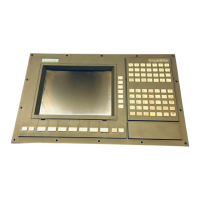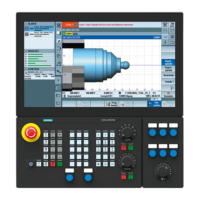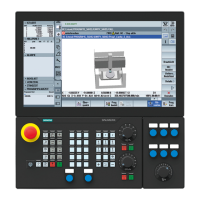Detailed description
2.3 Continuous -path mode
Basic logic functions: Continuouspath Mode, Exact Stop, LookAhead (B1)
Function Manual, 11/2006, 6FC5397-0BP10-2BA0
35
Adaptations
In order to clarify the adaptation processes sketched below, please note the following basic
principles:
The size of the time window is t
adapt
= 1 /
f
.
1. The time needed to change the velocity is less than t
adapt
:
The acceleration rates are reduced by a factor greater than 1 and less than the value
written in machine data:
MD20465 ADAPT_PATH_DYNAMIC (adaptation of the path dynamics)
The reduction in acceleration rate increases the time taken to change the velocity.
The following cases are different:
– The acceleration rate is reduced with a value less than MD20465 so that the process
lasts for t
adapt
[s]. The permitted reduction does not need to be fully utilized.
– The acceleration time is reduced with the value written in MD20465. The process lasts
less than t
adapt
despite the reduced acceleration. The permitted reduction was fully
utilized.
2. The time needed to change the velocity is greater than t
adapt
:
No dynamic response adaptation is required.
Example 1: Effect of dynamic response adaptation; acceleration mode: BRISK
Parameter assignment
Machine data
$MC_ADAPT_PATH_DYNAMIC[0] = 1.5
$MC_LOOKAH_SMOOTH_FACTOR = 1.0 See note
$MA_LOOKAH_FREQUENCY[AX1] = 20 Hz T
AX1
= 1/20 Hz = 50 ms
$MA_LOOKAH_FREQUENCY[AX2] = 10 Hz T
AX2
= 1/10 Hz = 100 ms
$MA_LOOKAH_FREQUENCY[AX3] = 20 Hz T
AX3
= 1/20 Hz = 50 ms
Note
A smoothing factor other than 0% prevents the default value of 100% from being used to
smooth the path velocity. To illustrate this effect, in contrast to Example 2 the smoothing of
the path velocity is practically deactivated.
AX2
For path motions in which axis AX2 is involved, all deceleration and acceleration processes
that would last less than T
AX2
are adapted.
AX1, AX3
If only axes AX1 and/or AX3 are involved in path motions, all deceleration and acceleration
processes that would last less than T
AX1
= T
AX3
are adapted. This time is designated t
adaptxy
in
the following diagrams:

